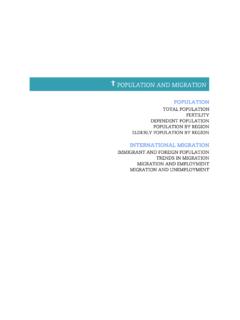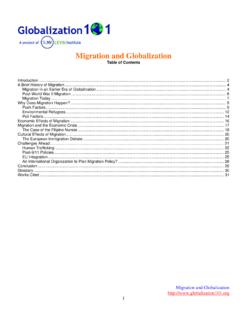Transcription of Addressing Rural Youth Migration at its Root Causes: A ...
1 Knowledge materialsaddressing Rural Youth Migration at its root causes : a conceptual frameworkrural employmentKnowledge materialsaddressing Rural Youth Migration at its root causes : a conceptual frameworkKnowledge materialsFOOD AND AGRICULTURE ORGANIZATION OF THE UNITED NATIONSRome, 2016m a r c h 2 016 by Laura Deotti and Elisenda Estruch, Social Policies and Rural Institutions Division Rural employmentThe designations employed and the presentation of material in this information product do not imply the expression of any opinion whatsoever on the part of the Food and Agriculture Organization of the United Nations (FAO) concerning the legal or development status of any country, territory, city or area or of its authorities, or concerning the delimitation of its frontiers or boundaries. The mention of specific companies or products of manufacturers, whether or not these have been patented, does not imply that these have been endorsed or recommended by FAO in preference to others of a similar nature that are not views expressed in this information product are those of the author(s) and do not necessarily reflect the views or policies of 978-92-5-109270-5 FAO, 2016 FAO encourages the use, reproduction and dissemination of material in this information product.
2 Except where otherwise indicated, material may be copied, downloaded and printed for private study, research and teaching purposes, or for use in non-commercial products or services, provided that appropriate acknowledgement of FAO as the source and copyright holder is given and that FAO s endorsement of users views, products or services is not implied in any requests for translation and adaptation rights, and for resale and other commercial use rights should be made via or addressed to information products are available on the FAO website ( ) and can be purchased through photo: FAO/M. LintoniiiKnowledge materials table of contentsAcknowledgements VExecutive summary VIAcronyms VIII1 introduction 12 Rural Youth Migration and employment.
3 Facts and figures 43 a conceptual framework for distress Migration of Rural Youth Determinants of distress Migration of Rural Youth Context determinants Household determinants Individual determinants Impact of Rural out- Migration on Rural livelihoods Positive impacts of Youth Migration on Rural areas of origin Negative impacts of Youth Migration on Rural areas of origin Potential policies and programmes Collect evidence and factor in gender- and age-disaggregated analysis of Rural distress Migration Integrate distress Migration and Rural labour mobility aspects in ARD policies and programmes Promote specific measures for Youth employment creation in both farm and non-farm Rural activities, in line with aspirations Support Migration that is informed, voluntary and within legal/formal migratory channels Promote measures to maximize the positive impact of Migration 354 conclusions and final recommendations 40 Bibliography 43 Glossary 55iVTABLE OF CONTENTSList of figures1.
4 Determinants of distress Migration of Rural Youth 102. Factors determining the direction and intensity of Migration impacts 163. Positive impacts of Youth Migration on Rural areas of origin 214. Negative impacts of Youth Migration on Rural areas of origin 235. Impact of policies supporting gender- and age-disaggregated analysis of distress Migration 266. Impact of policies integrating distress Migration and Rural labour mobility into ARD policies and planning 277. The Junior Farmer Field and Life School approach 318. Impact of policies including specific measures for Youth employment creation in farm and non-farm Rural activities 339. Impact of policies supporting informed, voluntary and regular Migration 3510. Impact of policies contributing to maximize the positive effects of Migration 3711. Summary of potential policies to reduce distress Migration of Rural Youth and maximize its benefits for agriculture and Rural development 38 List of tables1.
5 Impact of Migration on agriculture and Rural development 18 List of boxesElements of success for public-private partnership (PPP) models 29 Key actions to promote SMAEs 30 FAO s Junior Farmer Field and Life School (JFFLS) approach 32 VKnowledge materials The authors wish to thank the many individuals who contributed to the development of this conceptual are most grateful for the valuable feedback from numerous colleagues from the Decent Rural Employment Team, in the Social Policies and Rural Institutions (ESP) division of FAO. In particular, the authors wish to thank Francesca Dalla Valle and Ariane Genthon, for their valuable contributions and advice. We also thank Peter Wobst who provided continuous support, without which the completion of this document would not have been inputs and feedback from other colleagues in ESP are also greatly appreciated. Special thanks are due to Libor Stloukal, who provided technical inputs, especially on the demographic and gender aspects of authors would also like to recognize the excellent technical advice provided by Alan de Brauw (IFPRI) who reviewed in detail an advanced draft of the , we would like to thank Ruth Duffy for final editing and Andrea W hr for design and summaryMigration is a common livelihood strategy for households across sub-Saharan Africa (SSA) and North Africa.
6 Despite structural differences, these two regions are facing major Migration and Youth employment challenges. The literature has mainly concentrated on international Migration . Similarly, Migration policies have mainly tried to mitigate the potential risks and/or maximize the benefits of international Migration . However, a much greater number of people migrate inside their own country, and mainly out of Rural areas. If the root causes of Migration remain unaddressed, an increasing number of Rural households will revert to Migration out of distress. The number of young migrants increased from million in 1990 to million in 2013 (UNICEF, 2014). At household level, young members may move to work elsewhere as part of the household s risk diversification strategy but also in response to the household s expectation of higher returns in the future or to personal aspirations. In particular, Rural Youth are those more likely to migrate in response to the lack of gainful employment and entrepreneurial opportunities in agriculture and related Rural economic activities.
7 Rural Youth in SSA and North Africa are particularly disadvantaged. Relatively low official Youth unemployment rates in SSA mask endemic underemployment and the large number of poor quality informal jobs. On the other hand, Youth unemployment rates in North Africa are among the highest in the paper develops a conceptual framework about how agricultural and Rural development policies can reduce the need for distress Migration of Rural Youth ; and how Rural Youth Migration and remittances can contribute to sustainable agriculture and Rural development, poverty reduction and food security in the areas of conceptual framework recognizes that distress Migration is a complex phenomenon requiring integrated approaches which both address the root causes of distress Migration and emphasize the positive impacts of Migration for Rural areas. Indeed, a wide range of issues and situations determine the decision to migrate, including local factors and stages of structural transformation, as well as household and individual characteristics.
8 Likewise, the impacts of Migration on the Rural areas of origin can vary enormously. Based on available evidence, it may be concluded that within the ongoing processes of sustainable agricultural intensification and structural Rural transformation in SSA and North Africa, the root causes of distress Migration of Rural Youth need to be addressed by offering more and better on-farm and off-farm employment opportunities. The subsequent reduction in Rural poverty and improvement of food security can contribute to ease migratory pressures. ViiKnowledge materials This conceptual framework identifies a number of key areas for intervention at policy and programme levels: First, obtain a better understanding of the drivers and impacts of distress Migration of Rural Youth , through improved data and increased evidence to subsequently inform policies and programmes. At present, there is only limited data available about the propensity to migrate of Rural Youth in SSA and North Africa and about the impacts of Migration on agriculture and development in Rural areas of origin.
9 Comprehend the effectiveness of interventions to address the phenomenon at policy and programme level. A rigorous understanding and sound evidence are instrumental to raise awareness at global level by working in partnership and disseminating lessons learned. Second, ensure that agriculture and Rural development (ARD) policies and strategic planning processes account for Migration , labour mobility and remittances, while ensuring policy coherence. This calls for an integrated set of actions, for example: (i) increase awareness on Migration patterns, its determinants and impacts; (ii) provide technical support in strategic planning processes to address the root causes of Migration , especially in terms of employment creation for Rural Youth ; and (iii) develop the capacities of governments and Rural stakeholders to mainstream Migration aspects into ARD strategic , implement ARD programmes explicitly targeting Rural Youth to create viable on-farm and off-farm employment opportunities, which are productive, decent and in line with Youth aspirations.
10 There is an urgent need to engage Youth in agriculture and to allow them to realize their full productive and innovative potential. Therefore, programmatic interventions should accelerate the growth of agricultural and Rural sectors and value chains with high value added per worker and create decent job opportunities for Rural Youth , combining on-the-job training, employment-centred agro-investments (both in-farm and off-farm activities) and promotion of small and medium agro-enterprises (SMAEs). Innovative mechanisms establishing facilities to support migrants investments in agriculture, through remittances and diaspora funds, should also be piloted and scaled up. ViiiacronymsAfDB African Development BankARD Agriculture and Rural developmentATM Automated teller machineAVR Assisted Voluntary ReturnCSO Civil Society OrganizationCTA Technical Centre for Agricultural and Rural CooperationDFID Department for International Development (UK)DRE Decent Rural employmentEAAE European Association of Agricultural EconomistsESP Social Policies and Rural Institutions (FAO)

















